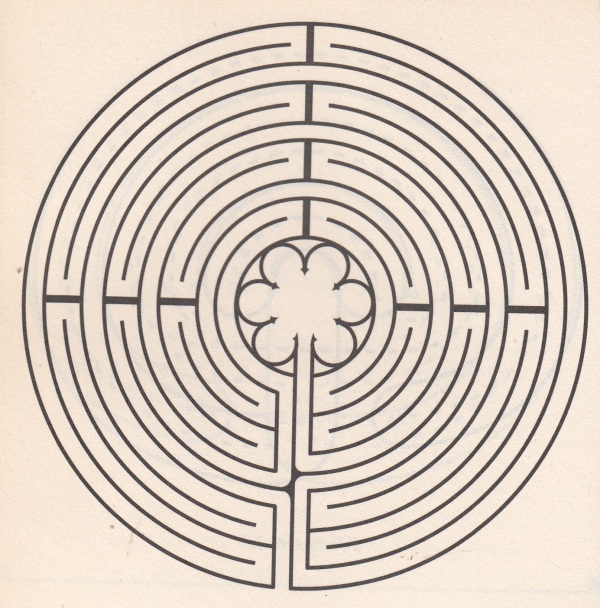So it took some explaining for me to appreciate the labyrinth. Mazes, I could understand the appeal, as those “require acute attention to choices at intersecting paths and a high degree of critical awareness to remember detours and dead ends. Mazes do not grace those who enter; they taunt, tease, and challenge.”

Cretan Labyrinth (pg. 81) “Exploring the Labyrinth” by Melissa Gayle West, Broadway Books NY 2000. ‘It is the oldest (…) form of the labyrinth, dating back at least 3,500 years.’
Labyrinths, in Melissa Gayle West’s case studies, do grace those who work with them. They provide a time and shape-of-space set out for liminality, for psychic (as in, pertaining to the psyche) development—yet, the structure is open enough that anyone can travel in them at their own pace, in their own way, with any approach they have. I find two common processes in the cases included in Exploring the Labyrinth: The first is those who have been harmed and hardened (into “small selves” as West describes it; having created a complex or intense focus around a specific issue) travel a labyrinth and gain a bigger perspective through that walking meditation; that intensity, or that defensiveness that precludes healing, tends to soften and release. The second are labyrinth-travelers who enter too lofty, too cerebral, and find the travel grounding—the labyrinth has an opposite effect of focus and integration.
Mentioned often, too, is the benefit of Second Thinking. If a traveler can catch how they approach the labyrinth, they can examine how they approach life. I’d considered labyrinths pretty but pointless. From entrance to center and out again, it’s too easy to be worth working with. It took more explaining before I could appreciate it.
Three labyrinths featured in the book included the organic, off-center Cretan labyrinth above, drawn from an equal-armed cross axis. West presented the Chartres labyrinth below as an innovation in labyrinth design that diverged from labyrinths throughout world history, but I can’t help but expect more than a surface scratching of art or architectural history would show the lineages and influences of it.

Chatres Labyrinth (pg. 96) “Exploring the Labyrinth” by Melissa Gayle West, Broadway Books NY 2000. ‘Named after the permanent stone labyrinth set into the floor of Chartres Cathedral in France during the thirteenth century…It is a distinctly Christian pattern, an equal-armed cross visible in its elegant layout.’
The third labyrinthine pattern, a simple spiral, made a brief mention.

Ibid.
My one’s more like a spiral, really, as the path doesn’t ebb to the periphery before flowing towards the center again. It just zigzags towards the center.

While the full-sized labyrinths are meant for walking meditations, I very much like the idea now of having a hand-held labyrinth to work with. The meditative mind state can be done while the labyrinth-traveler traces the path with their fingertips. Made out of pottery clay or salt dough, that would provide a tactile component, and of course the same time and symbolic shape-of-space that labyrinths make, to invite or facilitate that meditative mindset.
